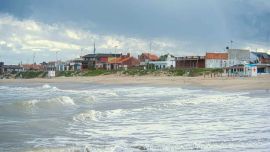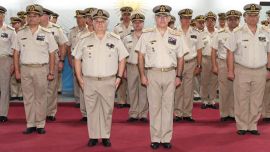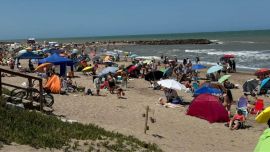Argentina’s a small country, after all. After a late arrival from Buenos Aires, my wife María Laura and I hopped downhill from our Ushuaia B&B to Kalma, a stylishly contemporary restaurant that rewarded us with inspired versions of king crab appetizers, black hake and Patagonian beef. We know its talented young chef, Jorge Monópoli, who was once my brother-in-law’s physical education student in Río Negro province.
To my budget backpacker’s eyes in the aftermath of the near-war with Chile, in 1979, Ushuaia still seemed like “the uttermost part of the earth” that Lucas Bridges described in his memoir. I’ve revisited at least a dozen times but my wife, who’s from Olavarría, couldn’t quite comprehend how a remote forlorn port had become a notable international destination and the gateway to Antarctica.
I’ve probably seen more of Argentina than she ever will. For nearly four decades, California’s been our home, but I’ve made a career out of writing about my Southern Cone travels. I’ve driven hundreds of thousands of kilometres through every Argentine province, yet rarely have we travelled together. In December, however, I finally showed her some places I’ve visited repeatedly.
Still, even after all this time, I hadn’t seen everything in and around Ushuaia. Two years earlier, a summer snowstorm had kept me from visiting the hilltop Arakur Ushuaia Resort, but this time we were able to walk through its Cerro Alarkén forest reserve and lunch with views of the Beagle Channel. I’d always wanted to hike the steep footpath up Cerro Guanaco, in Parque Nacional Tierra del Fuego, but my work schedule and the weather had never cooperated – not until our second full day. Then, we drove to the trailhead where a sign warned us that “if you are not wearing suitable walking shoes and clothes…” we should not continue.
As we climbed the switchbacks, a chicly kitted-out porteño couple critiqued my footwear. We heard condescending encouragement from younger hikers even after we reached the overlook, where we could see nearby Lago Acigami (ex-Lago Roca) and across the Channel to Chile’s Isla Navarino, ahead of them. Our only regret was that a late start kept us from visiting Harberton, the Bridges family’s historic ranch.
From Ushuaia, we flew to El Calafate. We’d both been there before and, because the local tour operator’s rigid guidelines deemed me too old and infirm for an ice trek (not a problem elsewhere) we declined to visit the Perito Moreno Glacier again. Instead, we chose a catamaran cruise on Lago Argentino where, unfortunately, company photographers badgered everyone to order cabin snapshots and national park regulations kept the vessel from approaching the Upsala Glacier, though we saw the Spegazzini at audible range. We more enjoyed our stay at Hotel Kosten Aike, for its quiet comfort, attentive service and walkability to restaurants like the hybrid wine bar La Zaina, with its rustic décor, and pleasantly surprising pub grub at the Mako Premium Bar.
Since we’re hikers, my wife had long wanted to visit El Chaltén, so we hired a car to reach Argentina’s “trekking capital.” En route, we snacked at the photogenic Parador La Leona, a rejuvenated roadhouse that’s retained a certain rusticism even as it’s become a stop for tourist buses to Chaltén and points much farther north along Ruta 40. Its current owners, the Kargauers, have cinema connections and Francis Ford Coppola even paid a visit there once.
Even with a late arrival, the long December day permitted her an afternoon hike toward the iconic Cerro Torre as I caught up with some writing at the Don Los Cerros hotel, a hilltop luxury lodge with panoramic views of the town and its surroundings. When María Laura returned, we walked to La Vinería, Chaltén’s only dedicated wine bar, for some empanadas and a glass of Malbec. Even for a village that lives off tourism, the quality of services — both accommodation and food — is remarkable here. My personal favourite is Estepa, where a succulent lamb with a calafate sauce is the specialty.
We’re both also avid cyclists and, the next morning, we arranged an excursion to Lago del Desierto, an area where Argentine and Chilean forces staged a 1965 firefight over the border’s precise location. Now, a truly adventurous route leads by boat across the lake and overland into Chile, where another vessel carries cyclists and hikers to the Carretera Austral, Chile’s dazzling Patagonian road.
We had neither time nor resources to do that, but my friend Javier Vásquez shuttles riders and bikes to the lake, where we began to pedal the 37 kilometres back to Chaltén with the wind at our backs — viento a favor. We were fine until about four kilometres short of town — when María Laura’s bike suffered a flat. Even as we pushed our bikes back to town and the wind worsened, that didn’t flatten our spirits. The next morning, we returned early to El Calafate.
There we moved uphill to Hotel La Cantera, which offered a view of the town and, after dinner at the now classic Casimiro where the bill included a 39-peso “covert charge” — an inadvertently accurate translation for cubierto. At mid-morning the next day we met María Laura’s cousin, who’d been out of town leading a tour group, for brunch at the new Olivia Coffee Shop, where the Swede in me found a delectable cinnamon roll.
Doing what I do, I often hear that “you’re getting paid to be on vacation,” but travelling has almost always been a job. A pleasurable job, but nonetheless a job. Still, as we boarded our flight back north that afternoon, I felt satisfaction at truly having been on vacation, with a loved one in tow.




















Comments